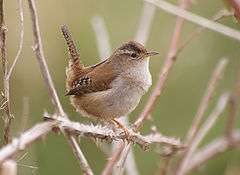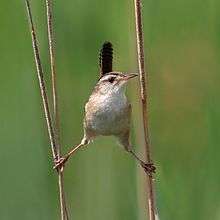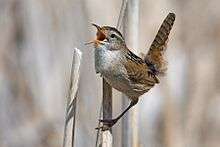Marsh wren
| Marsh wren | |
|---|---|
 | |
| A marsh wren in Canada | |
| Scientific classification | |
| Kingdom: | Animalia |
| Phylum: | Chordata |
| Class: | Aves |
| Subclass: | Neornithes |
| Infraclass: | Neognathae |
| Superorder: | Neoaves |
| Order: | Passeriformes |
| Suborder: | Passeri |
| Infraorder: | Passerida |
| Family: | Troglodytidae |
| Genus: | Cistothorus |
| Species: | C. palustris |
| Binomial name | |
| Cistothorus palustris (Wilson, 1810) | |
| Synonyms | |
|
Telmatodytes palustris | |
The marsh wren (Cistothorus palustris) is a small North American songbird of the wren family. It is sometimes called long-billed marsh wren to distinguish it from the sedge wren, also known as short-billed marsh wren.
Description

Adults have brown upperparts with a light brown belly and flanks and a white throat and breast. The back is black with white stripes. They have a dark cap with a white line over the eyes and a short thin bill.
The male's song is a loud gurgle used to declare ownership of territory; western males have a more varied repertoire.
Their breeding habitat is marshes with tall vegetation such as cattails across North America. In the western United States, some birds are permanent residents. Other birds migrate to marshes and salt marshes in the southern United States and Mexico.
These birds forage actively in vegetation, sometimes flying up to catch insects in flight. They mainly eat insects, also spiders and snails.
The nest is an oval lump attached to marsh vegetation, entered from the side. The clutch is normally four to six eggs, though the number can range from three to ten.[2] The male builds many unused nests in his territory. He may puncture the eggs and fatally peck the nestlings of other birds nesting nearby, including his own species (even his own offspring) and red-winged blackbirds, yellow-headed blackbirds, and least bitterns.[3]
This bird is still common, although its numbers have declined with the loss of suitable wetland habitat. Wholesale draining of marshes will lead to local extinction. Still, this species is widespread enough not to qualify as threatened according to the IUCN.
 |
|
| Problems playing this file? See media help. | |
Gallery
 Marsh Wren at Tule Lake National Wildlife Refuge, California
Marsh Wren at Tule Lake National Wildlife Refuge, California Iona, British Columbia, Canada
Iona, British Columbia, Canada Nest, illustration
Nest, illustration- Eggs
References
- ↑ BirdLife International (2012). "Cistothorus palustris". IUCN Red List of Threatened Species. Version 2013.2. International Union for Conservation of Nature. Retrieved 26 November 2013.
- ↑ "All About Birds: Marsh Wren". Cornell Lab of Ornithology. Retrieved 2008-07-20.
- ↑ Kroodsma, Donald E.; Verner, Jared (1997). A. Poole, ed. "Marsh Wren (Cistothorus palustris)". The Birds of North America Online. Cornell Lab of Ornithology. Retrieved 2013-03-03.
- Henninger, W.F. (1906): A preliminary list of the birds of Seneca County, Ohio. Wilson Bull. 18(2): 47-60. DjVu fulltext PDF fulltext
External links
| Wikimedia Commons has media related to the marsh wren. |
| Wikispecies has information related to: Cistothorus palustris |
- Identification tips - USGS Patuxent Bird Identification InfoCenter
- "Marsh wren media". Internet Bird Collection.
- Marsh wren photo gallery at VIREO (Drexel University)
- Interactive range map of Cistothorus palustris at IUCN Red List maps
